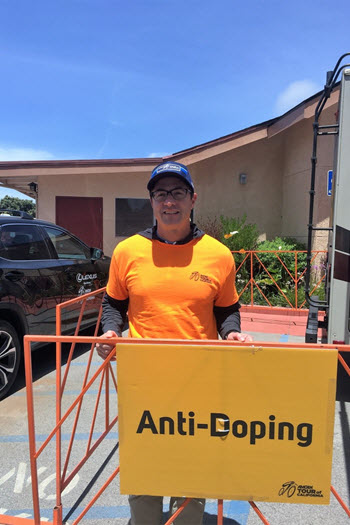
I have enjoyed bike riding throughout my life; whether it be delivering newspapers or cycling to school through my high school and college years. I still enjoy recreational riding, century (100-mile) rides, running errands and commuting to work on my bike. This includes my job as a part-time instructor in the Kinesiology Department at Stanislaus State, where I teach “Drugs in the Athletic Environment.” Recently, all of this experience paid off when I was offered the opportunity to help out in the post-race anti-doping process during the 2017 Amgen Tour of California.
When I moved to Turlock, I looked forward to taking some courses at Stan State. The Teacher Education Department and the Kinesiology Department provided the perfect curriculum to grow as a clinical educator and earn a graduate degree. That led to the opportunity of a lifetime — to teach at the university level.
In 2006, I was approached by physical education and health department chair Dr. Sue Fletcher about teaching the Drugs in the Athletic Environment course. The class explores the use of drugs and supplements and their impact on athletic performance. Today, the course is offered year-round to students with a wide range of majors and backgrounds.
All major professional, Olympic-level and NCAA sports have some level of drug testing to ensure fair competition, and professional cycling is known for its stringent anti-doping controls. I approached the Amgen Tour of California and was offered a volunteer position as one of four Medical Control Officer/Chaperone positions for the Stage 3 Finish in Morro Bay.
Here’s how it worked: after the race stage was completed, the chaperones had to keep their selected athlete in their line of sight until the rider reported to the anti-doping station for a sample collection. Two random riders were selected to be tested, along with the overall race leader and that day’s stage winner.
In Morro Bay, I had the responsibility to chaperone the stage winner, who ended up being two-time defending world champion Peter Sagan from Slovakia — one of the most popular riders in the field. After Sagan crossed the finish line in an epic come-from-behind victory, I accompanied him to the athlete’s “green room,” where he changed out of his racing gear and received health attention from his team’s support staff.
The next stop was the awards ceremony at the winner’s podium and then a press conference. Media commitments, awards ceremonies and medical attention come before any of the drug testing, so the time the athlete needs to be under observation can vary from just a few minutes to more than an hour. The athletes selected must remain under the chaperone’s constant supervision, with no bathroom breaks or any possible interactions that could affect the validity of the screening sample. The athletes are then taken to an anti-doping station trailer where United States Anti-Doping Agency and Union Cycliste Internationale staff retrieve urine samples — produced under direct observation — for analysis.
The process is very organized and specific. The selected athletes must sign, date and acknowledge they are complying with the testing procedures. After the strict protocol is completed, the cyclists were then free to greet fans and join their team to prepare for the next day’s competition.
This first-hand opportunity to participate in the competition testing procedures provided me with valuable insight into what athlete’s experience and what sports organizations have to do to maintain integrity in sports. I look forward to sharing this with my students at Stan State.